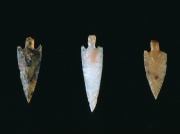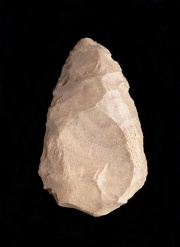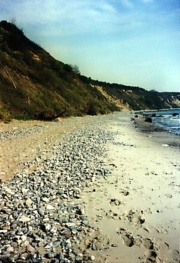Difference between revisions of "Flint"
| Line 1: | Line 1: | ||
| − | [[File:21.361-CR9457-d1.jpg|thumb|]] | + | [[File:21.361-CR9457-d1.jpg|thumb|Arrowhead<br>MFA# 21.361]] |
== Description == | == Description == | ||
A dense, tough, dark-color rock composed of microcrystalline [[quartz]]. Flint is generally a gray to black in color and has a waxy appearance. It tends to break with conchoidal chips. Flint is often found in [[chalk]] deposits and high quality flint is obtained from the coasts of Great Britain, France, Belgium and Germany. Flint has been used since Paleolithic times for weapons, tools, vessels and for starting fire. More recently, flint has been used on the firing mechanism of guns and as an [[abrasive]]. Flint is also used as an ingredient in fine pottery to reduce shrinkage and minimize deformation. | A dense, tough, dark-color rock composed of microcrystalline [[quartz]]. Flint is generally a gray to black in color and has a waxy appearance. It tends to break with conchoidal chips. Flint is often found in [[chalk]] deposits and high quality flint is obtained from the coasts of Great Britain, France, Belgium and Germany. Flint has been used since Paleolithic times for weapons, tools, vessels and for starting fire. More recently, flint has been used on the firing mechanism of guns and as an [[abrasive]]. Flint is also used as an ingredient in fine pottery to reduce shrinkage and minimize deformation. | ||
| − | [[File:11.788-CR6607-d1.jpg|thumb|]] | + | [[File:11.788-CR6607-d1.jpg|thumb|Scraper<br>MFA#11.788]] |
| − | + | [[File:Flintbeachf5.jpg|thumb|Flint nodules on beach]] | |
== Synonyms and Related Terms == | == Synonyms and Related Terms == | ||
flintstone; Lydian stone; touchstone; gun flint; potter's flint; hornstone; chalcedony; flintsten (Dan.); Feuerstein, Flint (Deut.); caliza (Esp.); silex (Fr., Port.); vuursteen (Ned.); krzemieñ (Pol.); flinta (Sven.) | flintstone; Lydian stone; touchstone; gun flint; potter's flint; hornstone; chalcedony; flintsten (Dan.); Feuerstein, Flint (Deut.); caliza (Esp.); silex (Fr., Port.); vuursteen (Ned.); krzemieñ (Pol.); flinta (Sven.) | ||
| − | == | + | == Physical and Chemical Properties == |
Fracture = conchoidal. Luster = dull. Streak = white. | Fracture = conchoidal. Luster = dull. Streak = white. | ||
| Line 23: | Line 23: | ||
|} | |} | ||
| − | |||
| − | |||
| − | |||
| − | |||
| − | |||
== Comparisons == | == Comparisons == | ||
| Line 40: | Line 35: | ||
</gallery> | </gallery> | ||
| − | + | ==Resources and Citations== | |
| − | == | + | * Mineralogy Database: [http://www.webmineral.com/data/Quartz.shtml Quartz] |
* C.W.Chesterman, K.E.Lowe, ''Audubon Society Field Guide to North American Rocks and Minerals'', Alfred A. Knopf, New York, 1979 | * C.W.Chesterman, K.E.Lowe, ''Audubon Society Field Guide to North American Rocks and Minerals'', Alfred A. Knopf, New York, 1979 | ||
| Line 53: | Line 48: | ||
* A.Lucas, J.R.Harris, ''Ancient Egyptian Materials and Industries'', Edward Arnold Publishers Ltd., London, 4th edition, 1962 | * A.Lucas, J.R.Harris, ''Ancient Egyptian Materials and Industries'', Edward Arnold Publishers Ltd., London, 4th edition, 1962 | ||
| − | * Wikipedia | + | * Wikipedia: http://en.wikipedia.org/wiki/Flint (Accessed Nov. 2, 2005) |
* Ralph Mayer, ''A Dictionary of Art Terms and Techniques'', Harper and Row Publishers, New York, 1969 (also 1945 printing) | * Ralph Mayer, ''A Dictionary of Art Terms and Techniques'', Harper and Row Publishers, New York, 1969 (also 1945 printing) | ||
Revision as of 11:00, 29 August 2020
Description
A dense, tough, dark-color rock composed of microcrystalline Quartz. Flint is generally a gray to black in color and has a waxy appearance. It tends to break with conchoidal chips. Flint is often found in Chalk deposits and high quality flint is obtained from the coasts of Great Britain, France, Belgium and Germany. Flint has been used since Paleolithic times for weapons, tools, vessels and for starting fire. More recently, flint has been used on the firing mechanism of guns and as an Abrasive. Flint is also used as an ingredient in fine pottery to reduce shrinkage and minimize deformation.
Synonyms and Related Terms
flintstone; Lydian stone; touchstone; gun flint; potter's flint; hornstone; chalcedony; flintsten (Dan.); Feuerstein, Flint (Deut.); caliza (Esp.); silex (Fr., Port.); vuursteen (Ned.); krzemieñ (Pol.); flinta (Sven.)
Physical and Chemical Properties
Fracture = conchoidal. Luster = dull. Streak = white.
| Mohs Hardness | 6.5 - 7.0 |
|---|---|
| Density | 2.60-2.65 |
Comparisons
Properties of Common Abrasives
Additional Images
Resources and Citations
- Mineralogy Database: Quartz
- C.W.Chesterman, K.E.Lowe, Audubon Society Field Guide to North American Rocks and Minerals, Alfred A. Knopf, New York, 1979
- CRC Handbook of Chemistry and Physics, Robert Weast (ed.), CRC Press, Boca Raton, Florida, v. 61, 1980 Comment: density=2.63
- Jack Odgen, Jewellery of the Ancient World, Rizzoli International Publications Inc., New York City, 1982
- Dictionary of Building Preservation, Ward Bucher, ed., John Wiley & Sons, Inc., New York City, 1996
- A.Lucas, J.R.Harris, Ancient Egyptian Materials and Industries, Edward Arnold Publishers Ltd., London, 4th edition, 1962
- Wikipedia: http://en.wikipedia.org/wiki/Flint (Accessed Nov. 2, 2005)
- Ralph Mayer, A Dictionary of Art Terms and Techniques, Harper and Row Publishers, New York, 1969 (also 1945 printing)
- Michael McCann, Artist Beware, Watson-Guptill Publications, New York City, 1979





